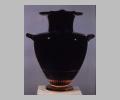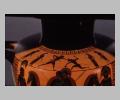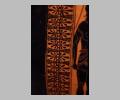
Shoulder: scene at center

Reverse side: overview

Main panel: scene at center

Shoulder: elevated view at center

Main panel: border at left

Main panel: predella at center
| Collection: | Cleveland Museum of Art |
| Summary: | Main panel: frontal quadriga flanked by two hoplites |
| Ware: | Attic Black Figure |
| Painter: | In the manner of the Antimenes Painter |
| Date: | ca. 520 BC |
| Dimensions: | h. 42.2 cm; d. of lip 24.7 cm; d. of base 15.5 cm; max. d. 29.7 cm, with handles 37.6 cm. |
| Primary Citation: | |
| Shape: | Hydria |
| Beazley Number: | 5188 |
| Period: | Late Archaic |
Condition:
Some minor plaster fill and some very minor in-painting.
Decoration Description:
Interior of neck and underside of lip well glazed; insides of side handles and portion of the vase body opposite are reserved.
Main panel: frontal quadriga flanked by two hoplites. A driver and warrior have already mounted the chariot whose horses appear alert and anxious. The faces of two hoplites-like the chariot itself-are shown frontally, a somewhat unusual feature at this time. The driver wears a fashionable headband and long robe which is traditional for the profession; he holds the reins and goad (kentron). The hoplite in the chariot carries two lances-reminiscent of heroic times-and wears a low-crested Corinthian helmet as does his companion standing to the right. The third wears the high-crested version. The "spectator" hoplites wear baldrics for sword and quiver, and carry lances and shields: device on the left a tripod, on the right, an octopus. Added red: chariot car, horses' manes and tails, tops of greaves, fillets, various bands on helmet-crests, folds of chitoniskoi, dot on shield of warrior on left; flair on bottom of breast plates and dot in their upper center. Added white: charioteer's robe, shield emblems (now faded). Shoulder: Theseus slaying the Cretan Minotaur with two youths and two maidens looking on. Theseus, his sword in hand, holds the Minotaur at arm's length; the monster defends himself with rocks. Added red: hair of nude youths, stripes on maidens' peploi and on Theseus' chiton and numerous dots on Minotaur's neck. Added white: women's flesh and Minotaur's rocks. Predella: two lions attack a doe while a stag grazes on either side. Added red: necks of animals and daubs on the haunch of the stag on the far right. A red band runs around the vase beneath the predella, and the hearts of the palmettes at either end of this little register are also red. Alternate red and black tongue-patterns at the base of neck; double palmette-lotus-chains frame the main panel on either side.
This exceptionally well-preserved hydria is among the finest vases of this painter who was named by Beazley after a love inscription on a hydria in Leyden (
Like many of his contemporaries at the end of the sixth century B.C., the Antimenes Painter was influenced by the revolutionary new style of the red-figure vase-painters. Artists of this new style sought to depict human beings in more realistic and active poses, often foreshortening and twisting their bodies, and increasing their size and bulk. In addition to a few practitioners experimenting with space such as we see on this hydria, black-figure artists mostly responded to this impetus with increasingly more complex treatment of detail. Here the various incisions, the unusually delicate detail of the charioteer's hands, the more studied and faithful treatment of the chariot box, and the larger human and equine forms crowding the limited space, reflect these new red-figure innovations. Thus, the Cleveland hydria may evidence a loosening of the Antimenes Painter's style, and an added interest in filling space with unified, heavier compositions, which kept his black-figure pottery desirable for a clientele with a taste for the old-fashioned in a period of growing demand for red-figure.
Essay:
Collection History:
Ex collection Tessin, Switzerland.
Sources Used:
Other Bibliography:
Das Tier in der Antike Archäologischen Institut der Universität, Zürich (21 September-17 November 1974) no. 225CMA Bulletin 66 (February 1979) 49-54, figs. 1, 2 and 4